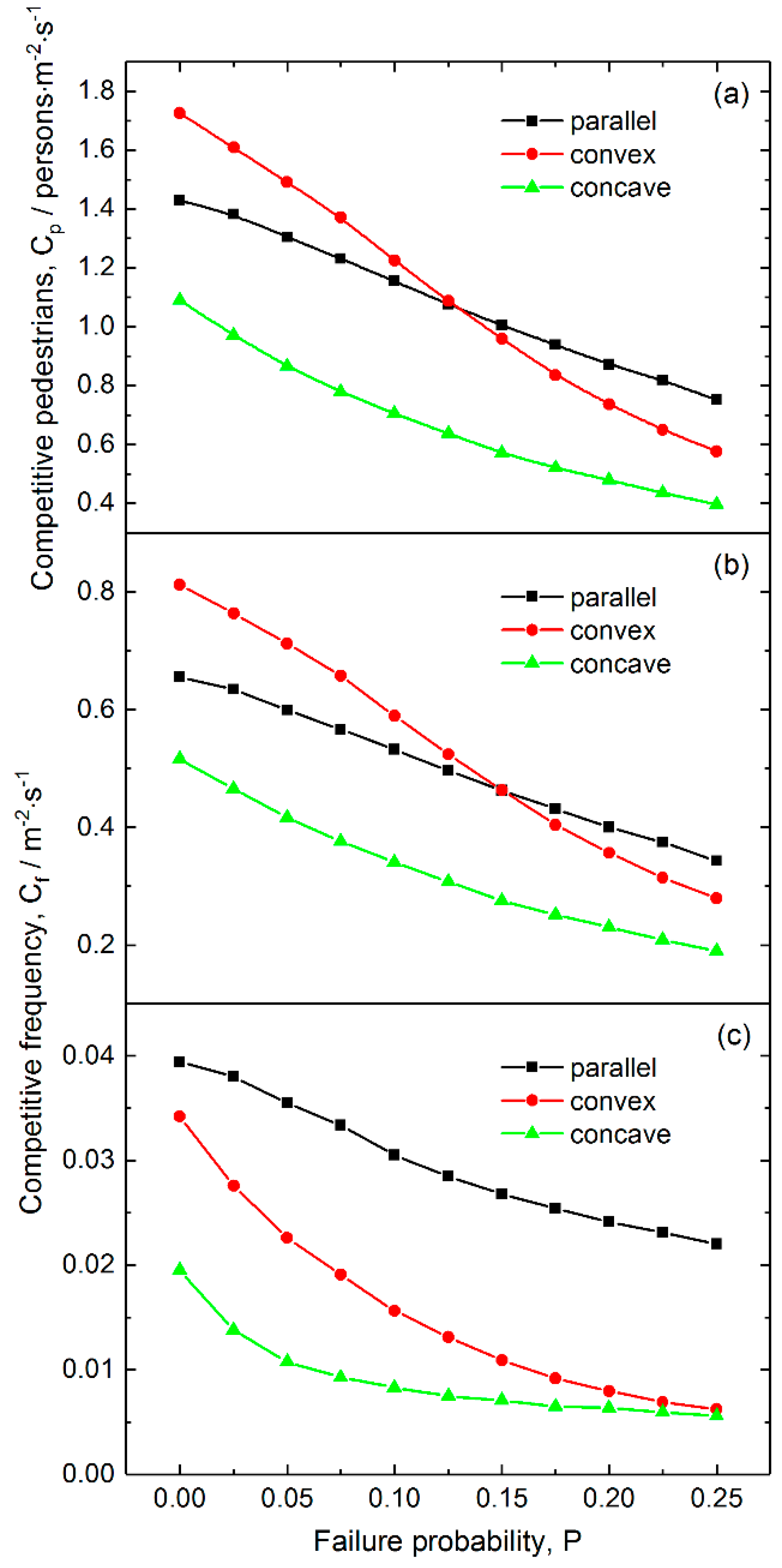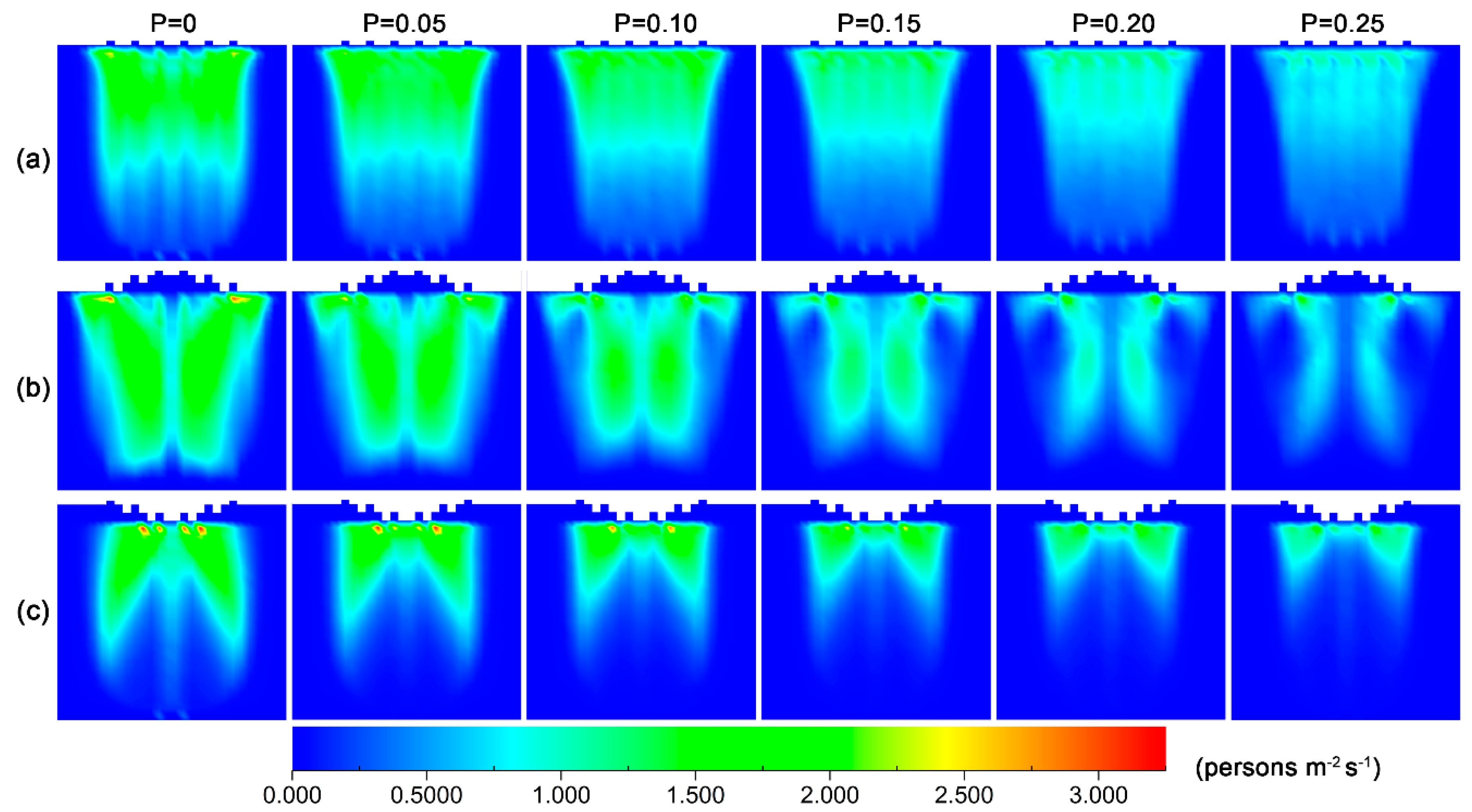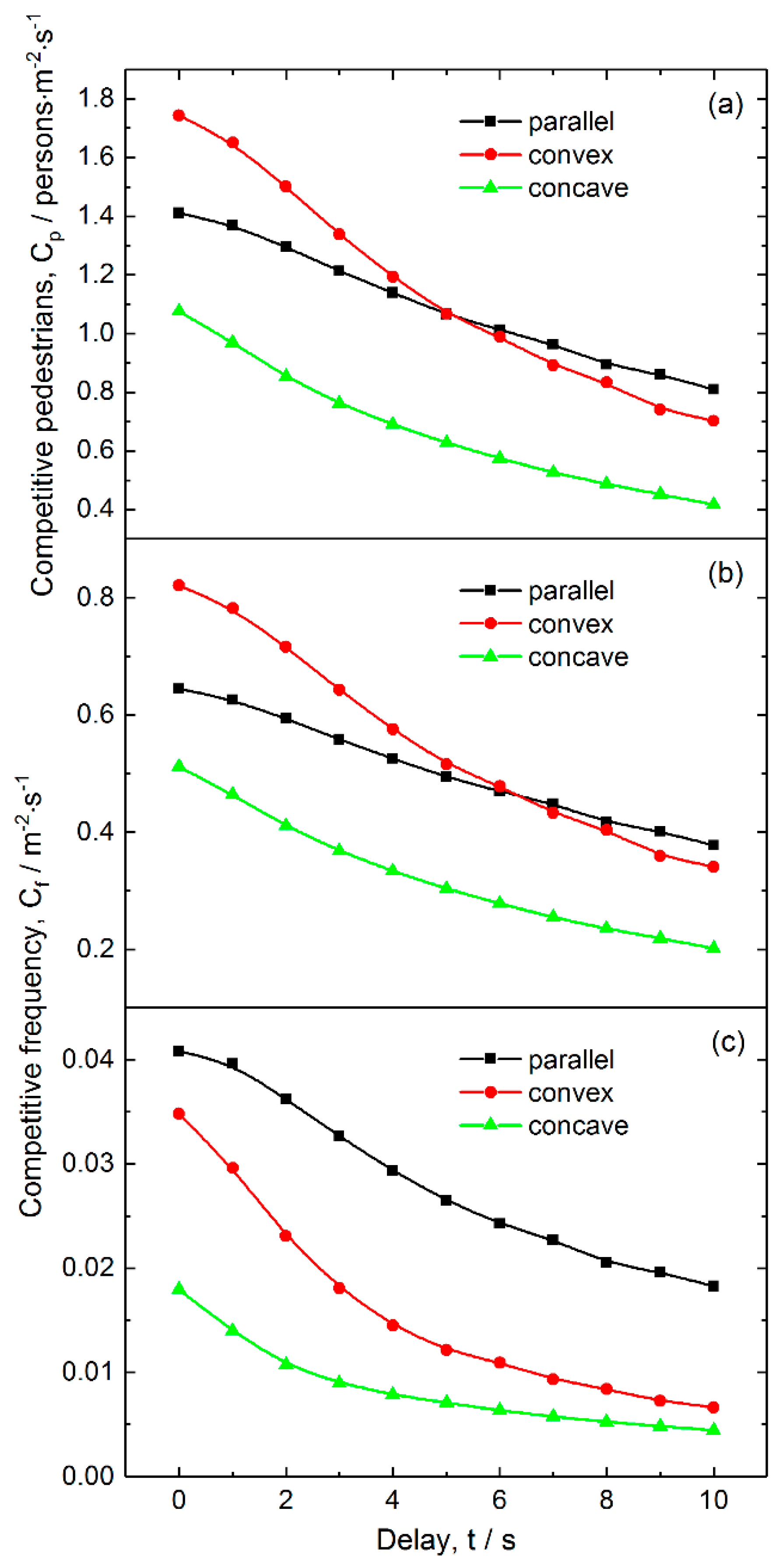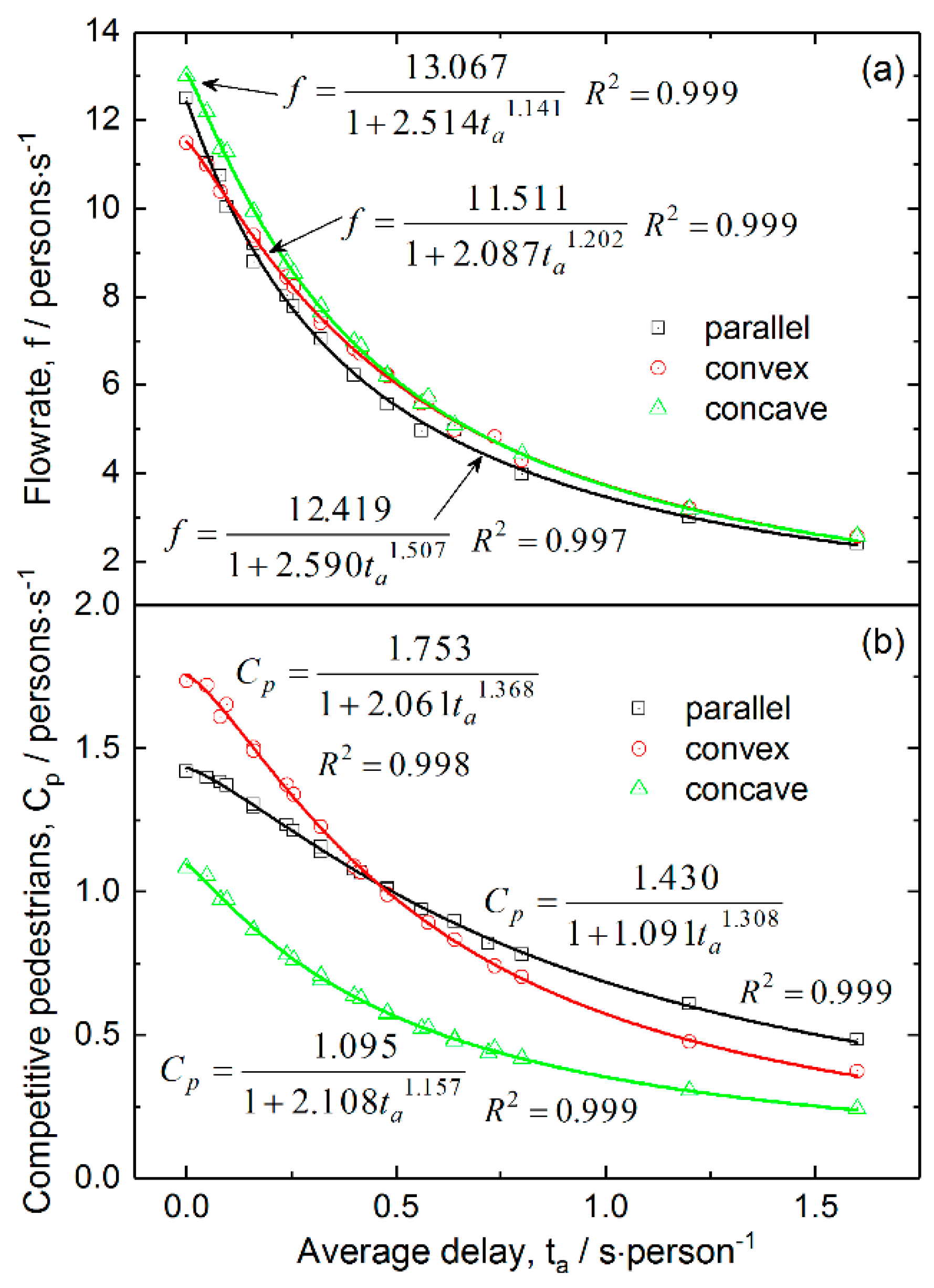Effects of Ticket-Checking Failure on Dynamics of Pedestrians at Multi-Exit Inspection Points with Various Layouts
Abstract
:1. Introduction
2. Model and Simulation Details
2.1. Cellular Automata Model
2.2. Simulation Details
3. Results and Discussion
3.1. Passing Efficiency
3.1.1. Effects of Pedestrian Density on Flowrate
3.1.2. Effects of Failure Probability on Flowrate
3.1.3. Effects of Delay on Flowrate
3.2. Passing Safety
3.2.1. Effects of Pedestrian Density on Competitive Level
3.2.2. Effects of Failure Probability on the Competition Level
3.2.3. Effects of Delay on Competitive Level
3.3. Equivalence of Failure Probability and Delay
4. Conclusions
Author Contributions
Funding
Acknowledgments
Conflicts of Interest
References
- Gershon, R.R.M.; Qureshi, K.A.; Barrera, M.A.; Erwin, M.J.; Goldsmith, F. Health and safety hazards associated with subways: A review. J. Urban Health 2005, 82, 10–20. [Google Scholar] [CrossRef] [PubMed]
- Li, Q.M.; Song, L.L.; List, G.F.; Deng, Y.L.; Zhou, Z.P.; Liu, P. A new approach to understand metro operation safety by exploring metro operation hazard network (MOHN). Saf. Sci. 2017, 93, 50–61. [Google Scholar] [CrossRef]
- Chen, Y.-Y.; Sung, F.-C.; Chen, M.-L.; Mao, I.-F.; Lu, C.-Y. Indoor air quality in the metro system in North Taiwan. Int. J. Environ. Res. Public Health 2016, 13, 1200. [Google Scholar] [CrossRef] [PubMed]
- Song, X.-Y.; Lu, Q.-C.; Peng, Z.-R. Spatial distribution of fine particulate matter in underground passageways. Int. J. Environ. Res. Public Health 2018, 15, 1574. [Google Scholar] [CrossRef] [PubMed]
- Sharma, D.; Bhondekar, A.P.; Shukla, A.K.; Ghanshyam, C. A review on technological advancements in crowd management. J. Ambient Intell. Humaniz. Comput. 2018, 9, 485–495. [Google Scholar] [CrossRef]
- Wang, Q.Q. Subway crowded and stampede neural networks safety assessment basing on shel model. In Man-Machine-Environment System Engineering, Mmese; Long, S., Dhillon, B.S., Eds.; Springer-Verlag Singapore Pte Ltd.: Singapore, 2016; Volume 406, pp. 455–468. [Google Scholar]
- Cao, Z.; Yuan, Z.; Zhang, S. Performance analysis of stop-skipping scheduling plans in rail transit under time-dependent demand. Int. J. Environ. Res. Public Health 2016, 13, 707. [Google Scholar] [CrossRef]
- Wang, J.H.; Yan, W.Y.; Zhi, Y.R.; Jiang, J.C. Investigation of the panic psychology and behaviors of evacuation crowds in subway emergencies. In Proceedings of the 2015 International Conference on Performance-Based Fire and Fire Protection Engineering, Guangzhou, China, 5–6 December 2015; Yao, H.W., Ed.; Elsevier Science Bv: Amsterdam, The Netherlands, 2016; Volume 135, pp. 128–137. [Google Scholar]
- Zhang, X.F.; Zhong, Q.; Li, Y.Q.; Li, W.; Luo, Q. Simulation of fire emergency evacuation in metro station based on cellular automata. In Proceedings of the 2018 3rd IEEE International Conference on Intelligent Transportation Engineering, Singapore, 1–3 September 2018; IEEE: New York, NY, USA, 2018; pp. 40–44. [Google Scholar]
- Wang, J.H.; Yan, W.Y.; Xu, H.; Zhi, Y.R.; Wang, Z.R.; Jiang, J.C. Investigation of the probability of a safe evacuation to succeed in subway fire emergencies based on bayesian theory. KSCE J. Civ. Eng. 2018, 22, 877–886. [Google Scholar] [CrossRef]
- Kong, D.S.; Zhang, W.W.; Zhang, Q.H.; Meng, Q.H. Research on dynamic responses of subway stations to explosive loads. In Advances in Civil Engineering, Pts 1–6; Zhao, J.Y., Ed.; Trans Tech Publications Ltd.: Stafa-Zurich, Switzerland, 2011; Volume 255–260, pp. 1765–1769. [Google Scholar]
- Ma, T.B.; Xu, X.Z.; Ning, J.G. Research on propagation laws of explosion shock wave inside metro station. J. Loss Prev. Process Ind. 2017, 46, 54–68. [Google Scholar] [CrossRef]
- Sun, L.; Luo, W.; Yao, L.; Qiu, S.; Rong, J. A comparative study of funnel shape bottlenecks in subway stations. Transp. Res. Pt. A Policy Pract. 2017, 98, 14–27. [Google Scholar] [CrossRef]
- Seyfried, A.; Passon, O.; Steffen, B.; Boltes, M.; Rupprecht, T.; Klingsch, W. New insights into pedestrian flow through bottlenecks. Transp. Sci. 2009, 43, 395–406. [Google Scholar] [CrossRef]
- Wang, C.Y.; Weng, W.G. Study on the collision dynamics and the transmission pattern between pedestrians along the queue. J. Stat. Mech. Theory Exp. 2018, 2018, 27. [Google Scholar] [CrossRef]
- Haghani, M.; Sarvi, M. Stated and revealed exit choices of pedestrian crowd evacuees. Transp. Res. Pt. B Methodol. 2017, 95, 238–259. [Google Scholar] [CrossRef]
- Joseph, J.K.; Babu, N.; Dev, K.A.; Pradeepkumar, A.P. Identification of potential health risks in mass gatherings: A study from sabarimala pilgrimage, Kerala, India. Int. J. Disaster Risk Reduct. 2016, 17, 95–99. [Google Scholar] [CrossRef]
- Liao, W.C.; Wagoum, A.U.K.; Bode, N.W.F. Route choice in pedestrians: Determinants for initial choices and revising decisions. J. R. Soc. Interface 2017, 14, 12. [Google Scholar] [CrossRef] [PubMed]
- Haghani, M.; Sarvi, M. Human exit choice in crowded built environments: Investigating underlying behavioural differences between normal egress and emergency evacuations. Fire Saf. J. 2016, 85, 1–9. [Google Scholar] [CrossRef]
- Fang, Z.; Song, W.; Zhang, J.; Wu, H. Experiment and modeling of exit-selecting behaviors during a building evacuation. Physica A 2010, 389, 815–824. [Google Scholar] [CrossRef]
- Zhao, H.; Gao, Z.Y. Reserve capacity and exit choosing in pedestrian evacuation dynamics. J. Phys. A Math. Theor. 2010, 43, 105001. [Google Scholar] [CrossRef]
- Yue, H.; Guan, H.; Shao, C.; Zhang, X. Simulation of pedestrian evacuation with asymmetrical exits layout. Physica A 2011, 390, 198–207. [Google Scholar] [CrossRef]
- Zhao, D.L.; Yang, L.Z.; Li, J. Exit dynamics of occupant evacuation in an emergency. Physica A 2006, 363, 501–511. [Google Scholar]
- Liao, W.C.; Zheng, X.P.; Cheng, L.S.; Zhao, Y.; Cheng, Y.; Wang, Y.F. Layout effects of multi-exit ticket-inspectors on pedestrian evacuation. Saf. Sci. 2014, 70, 1–8. [Google Scholar] [CrossRef]
- Liao, W.; Tordeux, A.; Seyfried, A.; Chraibi, M.; Drzycimski, K.; Zheng, X.; Zhao, Y. Measuring the steady state of pedestrian flow in bottleneck experiments. Physica A 2016, 461, 248–261. [Google Scholar] [CrossRef] [Green Version]
- Sun, L.S.; Gong, Q.S.; Yao, L.Y.; Luo, W.; Zhang, T.Q. A dynamic time warping algorithm based analysis of pedestrian shockwaves at bottleneck. J. Adv. Transp. 2018, 2018, 1269439. [Google Scholar] [CrossRef]
- Tang, T.Q.; Shao, Y.X.; Chen, L. Modeling pedestrian movement at the hall of high-speed railway station during the check-in process. Physica A 2017, 467, 157–166. [Google Scholar] [CrossRef]
- Tang, T.Q.; Shao, Y.X.; Chen, L.; Shang, H.Y. Modeling passengers’ boarding behavior at the platform of high speed railway station. J. Adv. Transp. 2017, 2017, 4073583. [Google Scholar] [CrossRef]
- Wang, L.; Zhang, Q.; Cai, Y.; Zhang, J.L.; Ma, Q.G. Simulation study of pedestrian flow in a station hall during the spring festival travel rush. Physica A 2013, 392, 2470–2478. [Google Scholar] [CrossRef]
- Helbing, D. A fluid-dynamic model for the movement of pedestrians. Complex Syst. 1992, 6, 391–415. [Google Scholar]
- Helbing, D.; Farkas, I.; Vicsek, T. Simulating dynamical features of escape panic. Nature 2000, 407, 487–490. [Google Scholar] [CrossRef] [Green Version]
- Helbing, D.; Molnár, P. Social force model for pedestrian dynamics. Phys. Rev. E 1995, 51, 4248–4286. [Google Scholar] [CrossRef]
- Kerridge, J.; Hine, J.; Wigan, M. Agent-based modelling of pedestrian movements: The questions that need to be asked and answered. Environ. Plan. B Plan. Des. 2001, 28, 327–341. [Google Scholar] [CrossRef]
- Huang, H.-J.; Guo, R.-Y. Static floor field and exit choice for pedestrian evacuation in rooms with internal obstacles and multiple exits. Phys. Rev. E 2008, 78, 021131. [Google Scholar] [CrossRef]
- Yuan, W.F.; Tan, K.H. An evacuation model using cellular automata. Physica A 2007, 384, 549–566. [Google Scholar] [CrossRef]
- Zheng, X.P.; Li, W.; Guan, C. Simulation of evacuation processes in a square with a partition wall using a cellular automaton model for pedestrian dynamics. Physica A 2010, 389, 2177–2188. [Google Scholar] [CrossRef]
- Zheng, X.; Li, H.Y.; Meng, L.Y.; Xu, X.Y.; Yang, Y.H. Simulating queuing behaviour of pedestrians in subway stations. Proc. Inst. Civ. Eng. Transp. 2017, 170, 373–380. [Google Scholar] [CrossRef]
- Lin, P.; Ma, J.; Si, Y.L.; Wu, F.Y.; Wang, G.Y.; Wang, J.Y. A numerical study of contact force in competitive evacuation. Chin. Phys. B 2017, 26, 7. [Google Scholar] [CrossRef]












| Group No. | Case No. | 1 | 2 | 3 | |||
|---|---|---|---|---|---|---|---|
| Prob. × Delay/s | Prob. | Delay/s | Prob. | Delay/s | Prob. | Delay/s | |
| 1 | 0.048 | 0.010 | 4.800 | 0.030 | 1.600 | 0.120 | 0.400 |
| 2 | 0.480 | 0.060 | 8.000 | 0.100 | 4.800 | 0.200 | 2.400 |
| 3 | 0.800 | 0.100 | 8.000 | 0.125 | 6.400 | 0.250 | 3.200 |
| 4 | 1.200 | 0.100 | 12.000 | 0.150 | 8.000 | 0.250 | 4.800 |
| 5 | 1.600 | 0.100 | 16.000 | 0.160 | 10.000 | 0.250 | 6.400 |
© 2019 by the authors. Licensee MDPI, Basel, Switzerland. This article is an open access article distributed under the terms and conditions of the Creative Commons Attribution (CC BY) license (http://creativecommons.org/licenses/by/4.0/).
Share and Cite
Jiang, M.; Jin, Q.; Cheng, L. Effects of Ticket-Checking Failure on Dynamics of Pedestrians at Multi-Exit Inspection Points with Various Layouts. Int. J. Environ. Res. Public Health 2019, 16, 846. https://doi.org/10.3390/ijerph16050846
Jiang M, Jin Q, Cheng L. Effects of Ticket-Checking Failure on Dynamics of Pedestrians at Multi-Exit Inspection Points with Various Layouts. International Journal of Environmental Research and Public Health. 2019; 16(5):846. https://doi.org/10.3390/ijerph16050846
Chicago/Turabian StyleJiang, Meiying, Qibing Jin, and Lisheng Cheng. 2019. "Effects of Ticket-Checking Failure on Dynamics of Pedestrians at Multi-Exit Inspection Points with Various Layouts" International Journal of Environmental Research and Public Health 16, no. 5: 846. https://doi.org/10.3390/ijerph16050846





